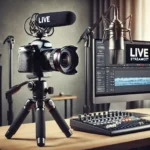Live streaming has rapidly evolved into a core medium for content creators, businesses, and casual users alike. Whether you’re gaming, hosting a webinar, or showcasing your artistic skills, having the right equipment is crucial for delivering high-quality streams that keep your audience engaged.
1. Camera
A high-quality camera is arguably the cornerstone of live streaming. Depending on your budget and the type of streams you’re planning, you’ll generally have three options:
- Webcams: Affordable and easy to use, webcams like the Logitech C920 offer excellent video quality for beginners.
- DSLR or Mirrorless Cameras: These are ideal for professional-level streams with superior image quality and depth of field.
- Action Cameras: Portable and durable, action cams like GoPro are great for on-the-go or outdoor streaming.
Regardless of the camera you choose, ensure that it supports HD or 4K resolution for crisp visuals.
2. Microphone
Audio quality is just as important as video, if not more so. A bad microphone can ruin the experience for your viewers. Here are a few popular options:
- USB Microphones: These are plug-and-play devices suitable for most starting streamers. For instance, the Blue Yeti offers excellent audio clarity.
- XLR Microphones: If you’re seeking professional studio-quality sound, XLR mics like the Shure SM7B are worth considering. These, however, require an audio interface or mixer.
- Lavalier Microphones: For those who prefer hands-free audio, lavalier mics are compact options perfect for interviews or mobile setups.
Don’t forget a pop filter or foam windscreen to reduce plosive sounds and improve speech clarity.
3. Lighting
Proper lighting can make a huge difference in how your stream looks. Even the best camera won’t perform well in poor lighting. Here’s what you can use:
- Ring Lights: Affordable and widely used, ring lights distribute soft, even lighting across your face.
- Softbox Lights: These provide more dispersed lighting with adjustable intensity and are great for professional setups.
- LED Panels: Compact and versatile, LED panel lights offer customizable brightness and color temperature.
Position the lights at an angle to soften harsh shadows and highlight your features naturally.
4. Capture Card
If you’re using a console or DSLR camera for streaming, a capture card is a must. This device converts the video feed into a format that your computer can process. Popular capture cards include:
- Elgato HD60 S: Best suited for console gaming and high-definition livestreams.
- AverMedia Live Gamer Mini: A more budget-friendly alternative for casual streaming.
Check for compatibility with your streaming platform and ensure low latency for real-time streaming.
5. A Stable Internet Connection
Without reliable internet, even the best equipment won’t save your stream. Here’s what you need:
- Wired Ethernet Connection: For a stable and fast connection, using an Ethernet cable is highly recommended.
- Upload Speed: Aim for at least 5 Mbps for 1080p streaming and 15 Mbps or higher for 4K streaming.
- Backup Plan: Invest in a portable 4G/5G hotspot or secondary ISP in case your primary connection fails.
6. Computer/Laptop
Your streaming setup is incomplete without a capable device to encode the stream and run your software smoothly. Key specs to look out for include:
- Processor (CPU): At least Intel i5 or AMD Ryzen 5 for encoding and multitasking.
- Graphics Card (GPU): A dedicated GPU like NVIDIA GTX 1660 or RTX 3060 enables smoother performance, especially for gaming streams.
- RAM: 16GB is the recommended minimum for fluid operation.
If you’re a gamer, consider a gaming laptop or PC with cooling to handle intensive tasks easily.
7. Streaming Software
No live stream is complete without software. It acts as the bridge between your hardware and the streaming platform. Some popular options include:
- OBS Studio: Free and open-source with countless plugins and customizations.
- Streamlabs: A beginner-friendly version of OBS with added features like alerts and overlays.
- XSplit: Paid software with robust options for professional streamers.
Learn the basics of your chosen streaming software to transition smoothly between camera sources and add effects or alerts.
8. Headphones
Proper monitoring ensures your stream looks and sounds perfect. Invest in a good pair of headphones to:
- Monitor audio latency.
- Adjust volumes in real time.
- Avoid audio feedback from speakers.
Over-ear headphones like the Audio-Technica ATH-M50X are known for their flat response, making them excellent for monitoring purposes.
9. Background Setup
Your stream’s visual appeal doesn’t only rely on your gear but also on the setting.
- Background Screens: Keep the focus on you with a green screen to modify backgrounds.
- Decorations: Add personality to your setup with LED light strips, posters, or themed elements.
- Furniture: A comfortable, ergonomic chair can make long streams more enjoyable while also enhancing your appearance.
10. Accessories & Extras
While the above covers the basics, a few optional items can significantly enhance your setup:
- Stream Deck: Elgato Stream Deck helps streamline actions like changing scenes or muting your mic.
- Tripods and Mounts: Ensure your camera stays stable during streams.
- Extension Cords/Power Strips: Keep all your equipment powered efficiently with surge-proof strips.
- UPS Backup: Protect your devices from power outages and provide emergency battery support.
Conclusion
Having the right equipment is essential for producing professional-quality streams that engage viewers. By investing in high-quality gear tailored to your needs and content type, you can elevate your live streams to the next level. Remember, while tools are important, your creativity and consistency will ultimately determine your streaming success.
